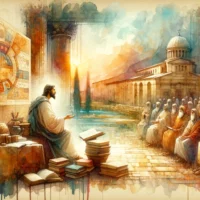The question of Jesus Christ’s existence is fascinating not only to believers but to historians and scholars as well. If Jesus truly walked the earth, what evidence do we have to support this? How do ancient texts outside the Bible corroborate His life and ministry? These questions are crucial for understanding the historical Jesus and the impact of His teachings on the world. The exploration of historical evidence invites us to consider not just biblical narratives but also external sources that mention Jesus, providing a broader context for His life and times.
Biblical Evidence of Jesus Christ
The biblical narrative offers a rich tapestry of evidence regarding Jesus Christ’s existence, presenting not only His teachings and miracles but also detailed aspects of His life, death, and resurrection. These accounts are primarily found in the four Gospels of the New Testament, each providing a unique perspective on Jesus’s life and ministry.
The Gospel of Matthew, written for a Jewish audience, emphasizes Jesus as the Messiah, fulfilling Old Testament prophecies. Through Matthew’s writings, readers learn about Jesus’s lineage, birth, and His role as the awaited King in Jewish tradition (Matthew 1-2). Luke, on the other hand, focuses on Jesus’s humanity and compassion, giving detailed accounts of His parables and healings, illustrating His concern for the poor, outcast, and sinners (Luke 4:18-19; 15:1-32).
Mark’s Gospel, considered the earliest, presents Jesus as a servant and a man of action. It highlights His miracles and authority over nature, demons, and sickness, showcasing His power and divinity (Mark 4:35-41; 5:1-20). John’s account provides a theological insight into Jesus’s identity as the Son of God, emphasizing His pre-existence and divine nature (John 1:1-14). John also records detailed conversations and teachings of Jesus, which are not found in the other Gospels, offering deep insights into His character and mission (John 3:1-21; 4:1-42).
The Acts of the Apostles and the Epistles further attest to Jesus’s historical existence and the early Christian community’s understanding of His life and teachings. Acts detail the spread of Christianity and the impact of Jesus’s message on the early church, while the Epistles provide theological reflections on His death and resurrection, affirming His role in salvation (Acts 2:22-36; Romans 1:3-4).
These New Testament documents, written within decades of Jesus’s life, offer a close historical perspective by those who were either eyewitnesses or had direct access to eyewitnesses of Jesus’s life and ministry. The consistency among the Gospel accounts and with other historical records of the time supports the reliability of the biblical testimony about Jesus.
The biblical narrative provides a comprehensive and multifaceted portrayal of Jesus Christ, from His birth, ministry, and teachings to His death and resurrection, as recorded in the Gospels and further attested by other New Testament writings. Through these accounts, we receive not only a historical glimpse into Jesus’s life but also the theological significance of His actions and words, affirming His identity as the Messiah and Son of God. The convergence of these texts, written by different authors at different times, underscores the depth and breadth of the biblical evidence for Jesus Christ’s existence and enduring impact.
External Historical Sources
The historical evidence for Jesus Christ extends beyond the biblical narrative, corroborated by several non-Christian sources from the first and second centuries. These external accounts provide a secular perspective on Jesus’s existence, offering an additional layer of validation to the New Testament descriptions.
Roman historian Tacitus, in his Annals written around AD 116, references Christus (Christ), who suffered under Pontius Pilate during the reign of Tiberius. Tacitus’s account is significant because it confirms the execution of Jesus, aligning with the biblical account of His crucifixion under Roman authority (John 19:16-18). Jewish historian Flavius Josephus, in his work “Antiquities of the Jews” (circa AD 93), mentions Jesus as a wise man and a doer of wonderful works, acknowledging His crucifixion at the hands of Pontius Pilate. Though some debate exists over the authenticity of parts of Josephus’s reference to Jesus, most scholars agree that the core mentions reflect historical recognition of Jesus’s life and death.
Additionally, the Talmud, a central text of Rabbinic Judaism, contains references to Yeshu (a name associated with Jesus), providing indirect evidence of Jesus’s historical presence. Although the Talmudic references are not entirely positive and are subject to interpretation, they nevertheless signify that Jesus was a notable figure in Jewish history.
Pliny the Younger, a Roman governor, wrote to Emperor Trajan around AD 112, seeking advice on dealing with Christians who worshiped Christ as a god. This correspondence highlights the early Christian practice of worshiping Jesus and the spread of Christianity as a distinct faith, further attesting to the impact of Jesus’s teachings.
These historical references, coming from sources outside of the Christian tradition, underscore the recognition of Jesus as a historical figure by various segments of ancient society. The convergence of these accounts with the New Testament narrative strengthens the case for Jesus’s historical existence and the profound influence of His life and teachings.
The validation of Jesus Christ’s existence is reinforced by accounts from Roman, Jewish, and other non-Christian sources from the first and second centuries. These external historical sources, including writings by Tacitus, Flavius Josephus, references in the Talmud, and correspondence from Pliny the Younger, corroborate biblical accounts of Jesus’s life, death, and the impact of His teachings. The agreement between Christian and non-Christian sources on key aspects of Jesus’s life provides a solid foundation for acknowledging His historical presence and significance.
Analyzing the Historical Validity
The historical validity of Jesus Christ is not only a matter of faith but also a subject of academic inquiry and historical analysis. This examination involves assessing the credibility of the biblical accounts, corroborating these narratives with external sources, and understanding the historical context of the time.
The Gospels, written by different authors with diverse audiences in mind, offer a multi-faceted picture of Jesus. The diversity in perspective and detail among the Gospels (Matthew, Mark, Luke, and John) strengthens their historical reliability. Each author provided unique insights and emphasis, yet they converge on the core aspects of Jesus’s life, teachings, death, and resurrection, suggesting a well-grounded historical basis for these events.
Historical analysis also involves evaluating the consistency and timing of the biblical texts with known historical facts. The New Testament writings were completed within the first century, with some parts written just a few decades after Jesus’s death. This proximity in time reduces the likelihood of mythologization or legend development, which typically takes longer to occur. Early Christian writings, including those by Paul, Peter, and James, who were contemporaries of Jesus, offer firsthand or near-firsthand accounts, lending further credibility to the historical existence of Jesus.
The mention of Jesus in non-biblical sources, such as writings by Tacitus, Josephus, and mentions in the Talmud, as well as references by Pliny the Younger, provides external corroboration of the New Testament narratives. These accounts from Roman historians and Jewish texts indicate that Jesus was a figure known to both supporters and skeptics, suggesting a basis in historical reality rather than myth.
Furthermore, the rapid spread of Christianity and the willingness of early Christians to face persecution and death for their beliefs underscore the profound impact of Jesus’s life and teachings. This historical phenomenon points to the existence of a compelling and influential figure at the heart of Christian faith.
The archaeological and historical context of first-century Judea and the broader Roman Empire also aligns with the details provided in the biblical accounts, adding a layer of authenticity to the descriptions of places, customs, and political dynamics mentioned in the Gospels.
The historical validity of Jesus Christ is supported by a comprehensive analysis of biblical accounts, corroborated by external sources, and understood within the historical context of the time. The convergence of evidence from diverse narratives, early Christian writings, non-Christian historical records, and archaeological findings strengthens the case for Jesus’s historical existence and the authenticity of His teachings and impact. This multifaceted approach provides a solid foundation for the historical understanding of Jesus Christ.
Evidence Beyond Belief
The evidence for Jesus Christ spans both sacred scripture and secular history, offering a robust foundation for belief. This article has outlined the biblical testimonies and external sources that collectively affirm Jesus’s historical existence and impact. From the detailed gospel accounts to corroborations by Roman and Jewish historians, the narrative of Jesus stands on solid historical ground. This fusion of faith and history not only enriches our understanding but also strengthens our conviction in the truth of Christianity.
Key takeaways:
- The Gospels provide a multifaceted, historically credible account of Jesus’s life and teachings.
- External historical sources from the first and second centuries corroborate the biblical narrative of Jesus.
- The rapid spread of Christianity and the archaeological context of the era further validate the historical existence of Jesus Christ.
Further reflections:
- What does the historical evidence of Jesus Christ mean for your faith?
- How can this blend of faith and historical fact impact your approach to sharing the Christian message?
- In what ways does understanding the historical context of Jesus’s life enhance your spiritual journey?
Let the knowledge of Jesus’s historical presence be a beacon that guides your faith. In the vast expanse of history, the reality of Christ stands as a testament to truth, inviting us to anchor our beliefs not just in the spiritual realm but also in the tangible evidence of His time on earth. This understanding not only deepens our faith but inspires us to live out His teachings with renewed conviction and purpose.













